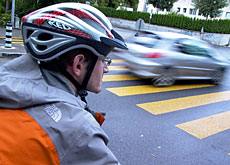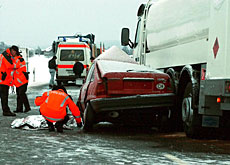Swiss cyclists may be forced to wear helmets

Crash helmets could become compulsory for Swiss cyclists from 2012, if by then less than half of all bicycle users are choosing to wear them.
But the Federal Roads Authority plan has been criticised by cycling associations, who are calling for alternative measures.
Cycling helmets come in all colours and sizes, and at a price most people can afford. But while they are widely available, they remain as unappealing for some riders as car seat belts are for a large number of drivers.
Like the seat belt, the helmet could become obligatory if it is included in a new package of security measures being considered by the roads authority.
Cut road deaths
The idea is not new. Back in 2002, it was already part of a far-reaching security package aimed at cutting the number of deaths and injuries on Swiss roads to nought by 2020.
The fact it was not introduced was largely due to the Swiss Bicycle Advocacy Association – an umbrella organisation representing the interests of cyclists. While recommending helmet use, the association rejected the idea of making headgear compulsory.
The authorities hope that cyclists will choose to protect their heads. But their patience will only stretch so far. If less than 50 per cent of riders are using helmets by 2012, the era of choice will be over.
“We will have no choice but to make helmets obligatory,” said roads authority spokesman Thomas Rohrbach.
Less attractive
The Swiss Bicycle Advocacy Association remains adamant that forcing riders to wear helmets is the wrong approach.
The association voted against the proposal last March, saying that such a measure would be counterproductive.
“Cycling would become less attractive and the number of cyclists would drop off,” director Christoph Merkli told swissinfo.
Merkli cites Australian statistics that show that the introduction of compulsory helmets in 1992 lead to a 30 per cent drop in bicycle use.
In the United States, where some states implemented the same type of rule, a 21 per cent drop was recorded.
Sense of security
Käthi Diethelm, a member of the association’s board, says that the more motor vehicles there are on the roads, the greater the risk for bike users.
“The individual rider feels safer where there are more cyclists on the road,” she told swissinfo.
The association says that helmets can also lull riders into a false sense of security.
“Specialists tend to agree that helmets by themselves are of very little use in protecting cyclists from life threatening head injuries,” Diethelm commented.
Diethelm, who is also vice-president of the European Cyclists’ Federation, is convinced that familiarity with traffic conditions, fear and proper evaluation of risk are equally important safety factors.
She is calling on the authorities to examine the effectiveness of helmets and other safety measures.
These would include the creation of more 30-kilometre-per-hour zones in towns, where cyclists feel safer, a feeling borne out by lower accident rates.
Statistics
The association says cyclists and drivers must also learn to respect one another, and suggests special courses might be the answer.
But Diethelm says that before any measures are decided, accident statistics should be improved.
“When a cyclist is involved in an accident we should know how long they had been on the road and what speed they were doing when it happened,” she said.
She also advocates making a distinction between people who use their bicycle as a means of transport, and cyclists out for a Sunday ride. “These are two very different groups,” she told swissinfo.
In Diethelm’s view, people should wear helmets if they feel like it, but they shouldn’t let safety concerns take the fun out of cycling. And she admits that while she has fallen over on the odd occasion, she doesn’t wear any head protection.
swissinfo, Renat Künzi
In Switzerland, one third of all cyclists wear a crash helmet.
In 2003, 30 cyclists were killed on the roads, and 1,500 others suffered head injury.
More than 540 people were killed on Swiss roads last year, and more than 5,600 were seriously injured.
The authorities want to cut the number of deaths to fewer than 300 by 2010.
The Federal Roads Authority has proposed a package of 58 measures to improve road safety.
Experts and politicians will consider these measures this autumn.
The Swiss Bicycle Advocacy Association believes that riders should not be forced to wear a helmet, recommending other measures instead.

In compliance with the JTI standards
More: SWI swissinfo.ch certified by the Journalism Trust Initiative



You can find an overview of ongoing debates with our journalists here. Please join us!
If you want to start a conversation about a topic raised in this article or want to report factual errors, email us at english@swissinfo.ch.